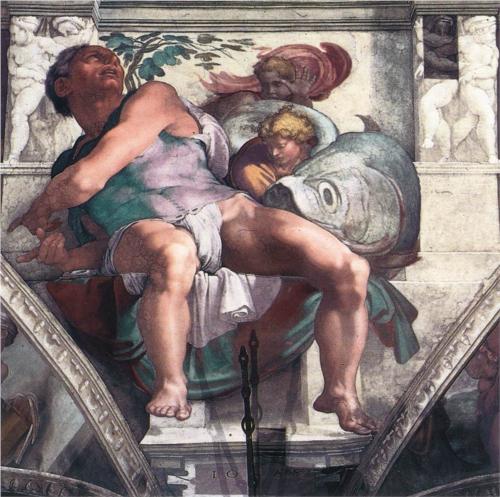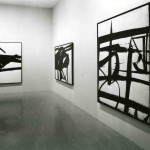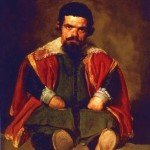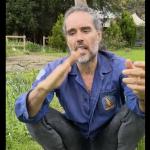 Hans Holbein the Younger, The Body of the Dead Christ in the Tomb, 1520-22, oil on panel, Öffentliche Kunstsammlung, Basel.
Hans Holbein the Younger, The Body of the Dead Christ in the Tomb, 1520-22, oil on panel, Öffentliche Kunstsammlung, Basel.
In The Idiot (1869), Dostoyevsky’s Prince Mishkin notices a reproduction of Holbein’s Dead Christ on the wall in Rogozhin’s house, and observes that it has the power to make one lose their Christian faith. The painting is unusual because Holbein painted it in the form of a predella, which forms the base of an altarpiece, featuring Christ’s crucifixion and resurrection. But there is no altarpiece to put Holbein’s dead Christ in context. Mishkin’s fear is that without the context of the resurrection provided by the altarpiece, the dead Christ deprives the Christian of hope. Because Holbein’s painting offers no resurrection, it cannot proclaim anything but death, its unrelenting power to vanquish even the Son of God. Dostoyevesky was fascinated with the painting the first time he saw it in Basel and apparently his wife had to pull him away from it after hours of close inspection. No doubt Dostoyevsky was fascinated by the implications of the image of God’s body, beginning to decay. Holbein gives us the most terrifying painting of law in the Western tradition. Munch’s The Scream rips our sanity from us; Holbein’s painting shows that the law kills God himself.
Yet Thomas Kinkade, who died on Good Friday, produced paintings that are far more terrifying than Munch’s and Holbein’s, giving us a world deprived not only of Easter Sunday, but Holy Saturday, Good Friday, and Christ himself. Kinkade claimed, “I like to portray a world without the Fall.” My professional colleagues dismissed Kinkade’s work as harmlessly trite, uninteresting, nostalgic, and sentimental illustrations that provide consumers with an “art-like” experience without the rigors and demand of attending seriously to learning the tradition of serious art. And I agree. Looking at serious painting, reading serious poetry, listening to serious music, requires work and practice and a willingness to be changed, or, as literary critic George Steiner has written, to be converted.
But Kinkade’s images prey on his audience’s preconceptions, expectations, and presumptions, restricting rather than broadening or deepening their experience. In the weeks to come, I will write about the artistic problems inherent in Kinkade’s work, problems which infect a large swath of the contemporary art world as well. But from a theological perspective, his work is not merely problematic, it is dangerous. Kinkade and his devotees have long railed against the nihilism of modern art and the contemporary art world. But because it denies the very foundation of our relationship to God in Christ, Kinkade’s work is more nihilistic than anything Picasso and Pollock could paint, or Nietzsche and Sartre could write.
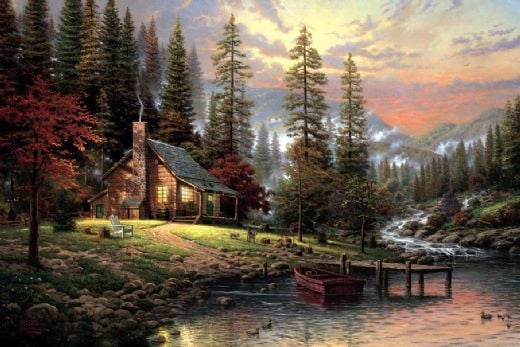 Thomas Kinkade, A Peaceful Retreat
Thomas Kinkade, A Peaceful Retreat
Because it is an outgrowth of his (imagined) view of a world “before the Fall,” Kinkade depicts a world governed by obedience to the law. Reformed theologian Michael Horton, in his recently published magisterial systematic theology, writes, “Law comes before gospel because creation comes before the Fall.” But the Edenic world Kinkade projects is pretty much the fallen world without the dirtiness of the city and the inconvenience of other people, a weekend getaway in the country. All we need to do to return to Eden is get our lives in order. Kinkade’s much ballyhooed “light” merely adds atmosphere and glow, a pleasant touch to an already charming scene. And because it makes us so comfortable, it is a very dark light indeed.
Kinkade’s work is the meticulously painted smile on the Joker’s disfigured face. It refuses to deal with the fallenness, brokenness, sinfulness of the world. And more troubling, it enables his clientele to escape into an imaginary world where things can be pretty good, as long as we have our faith, our family values, and a visual imagery that re-affirms all this at the office and at home. That Kinkade and his followers believe this to be “Christian art” is an affront to art, which time and again offers us grace, or at least brings us to the place where we realize that grace is our only hope. Art can do this because it often cuts through our self-deception to show us the reality of our souls. And this occurs because painters, poets, musicians, and writers probe the depths of human suffering and brokenness, and in that black pit, a flickering light can often be found. Some artists might give us only the black pit. But that is at times enough. We need art to remind us that we are not okay. We don’t just need a boost, a change of scenery or a weekend getaway. We need to be killed so that we can be raised again. Art can and should at times kill us, destroy our pretensions to virtue, goodness, and our desire to enlist art in our self-improvement schemes. And because being confronted with the hopelessness of our depravity is unbearable and our recognition that we cannot justify ourselves so utterly contrary to our fallen nature, we must have art to confront us. For it is only then, when brought to the very end of ourselves, that we can receive grace. In his book, Disruptive Grace: Studies in the Theology of Karl Barth (Eerdmans, 2002), George Hunsinger wrote, “Grace that is not disruptive is not grace…The grace of God really comes to lost sinners, but in coming it disrupts them to the core. It slays to make alive and sets the captive free.” Munch’s little oil and pastel bomb, The Scream, destroys any pretense to human stability without grace while Holbein’s Dead Christ gives us God himself succumbing to death, the unwavering conclusion of the law.
But Kinkade’s work refuses to take us to the end of ourselves, refuses the confrontations and disruption that could open us up to grace. His images give us a world that’s really okay, a world in which all we need is home and hearth, a weekend retreat, a cozy night with the family to put us right with God. It is a world devoid of pain and suffering; devoid of any fear of insanity or suicide. As a result, it is also a world without grace, without the Word that offers it. Kinkade’s multi-million dollar empire was built on our fallen human refusal to confront our innate hopelessness and our need to do what the Ninevites did in the book of Jonah, rip our clothes, put on sackcloth and ashes, and beg for God’s grace. “Who knows? God may turn and relent and turn from his fierce anger, so that we may not perish” (Jonah 3: 9).
Although his visual imagery refused to acknowledge violence and desperation, Kinkade’s personal life was full of it. I can only imagine the excruciating pressure he felt to live up to these deceptively dangerous paintings, which deprived him of the grace he so desperately needed. If only Kinkade could have used his considerable artistic gifts to produce work that came out of his fear, anger, desperation, and his struggle with faith in Christ, he just might have become a painter of Light.







